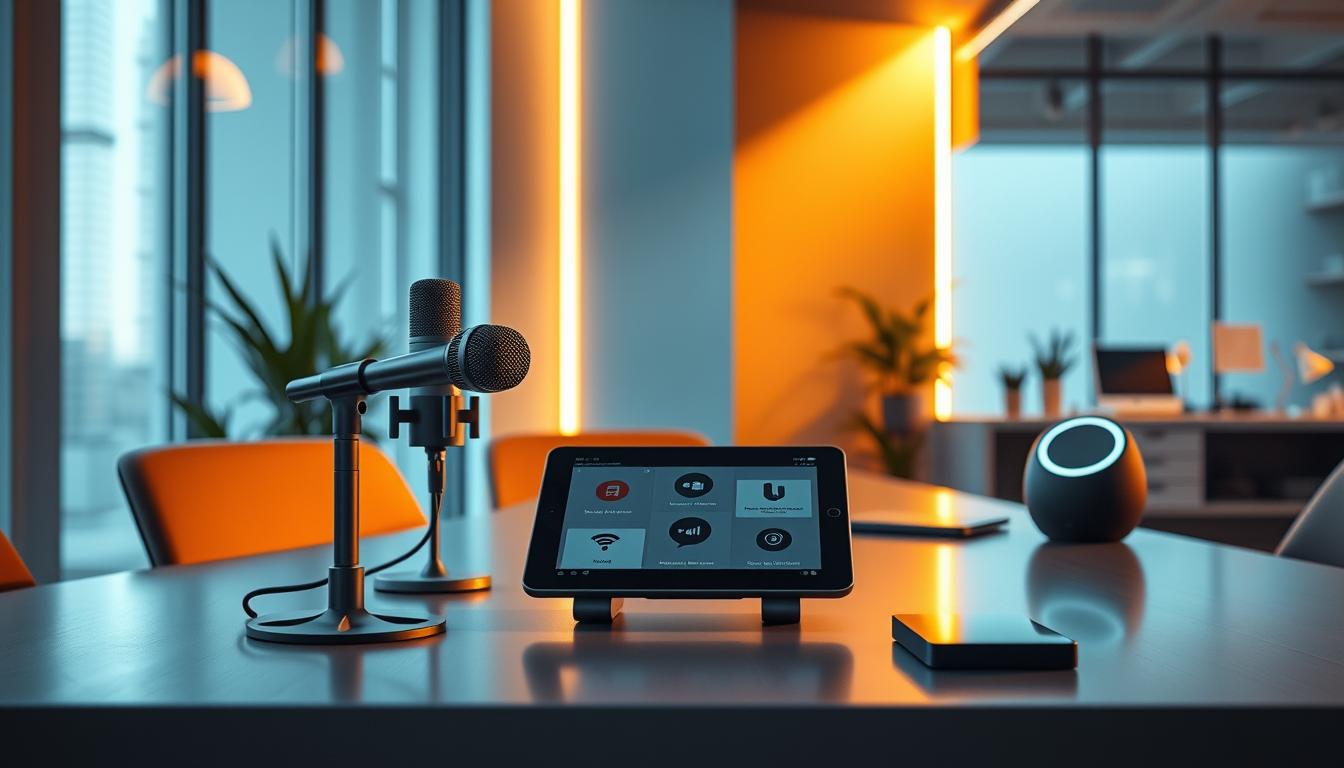Optimize for Voice Commerce Using Group Buys
Imagine a world where shopping happens through casual conversation—no screens, no typing, just speaking. With over 85% of Americans owning smartphones and 32% using smart speakers, this future is already here. Yet many businesses still treat voice-driven interactions as optional, risking irrelevance as consumer habits evolve.
Voice technology isn’t just changing how customers search for products—it’s redefining convenience. People now order groceries while cooking, compare prices during commutes, or restock supplies hands-free. By 2023, voice-driven sales could hit $19.4 billion, creating urgency for brands to adapt or fall behind.
But how can smaller businesses compete without breaking the bank? Platforms like Toolsurf.com offer a solution: affordable access to premium tools like Semrush and Jasper AI. These resources help companies optimize for natural language queries and conversational trends, leveling the playing field against larger competitors.
The shift isn’t just about technology—it’s about meeting customers where they are. Early adopters gain loyalty by simplifying shopping for those multitasking or facing physical barriers. As voice becomes the new search bar, businesses that act now will shape tomorrow’s commerce landscape.
Key Takeaways
- Voice-driven sales could grow 320% by 2023, making adaptation critical.
- Over 85% of U.S. consumers use devices capable of voice commerce daily.
- Conversational interfaces improve accessibility for users with disabilities or busy lifestyles.
- Cost-effective tool access enables small businesses to compete in voice optimization.
- Brands adopting voice strategies now build stronger customer loyalty and market share.
Understanding Voice Commerce and Emerging Trends
Did you know 3 out of 4 smartphone owners use voice commands weekly? This shift in how people interact with devices is rewriting the rules of retail. Brands now face a simple choice: adapt to spoken-word interactions or miss out on the fastest-growing sales channel.
Market Insights and Growth
The voice recognition sector grew 24% last year, fueled by smarter AI and mobile shopping habits. Smart speakers now sit in 42% of U.S. homes, creating endless opportunities for instant purchases. Early adopters see tangible results—voice shoppers spend $136 more annually than traditional online buyers.
Consumer Behavior with Voice Assistants
People aren’t just asking about the weather anymore. Over 60% of smart speaker owners have made purchases through devices like Amazon Echo. What keeps them coming back? Speed and simplicity—80% report satisfaction with voice-driven transactions compared to standard checkout processes.
This tech isn’t confined to living rooms anymore. Cars, watches, and even kitchen appliances now host voice assistants, letting people shop during commutes or while cooking dinner. As one retail analyst noted: “Voice is becoming the remote control for daily life.”
The Role of Group Buys in Modern eCommerce
What if your favorite store offered premium services at garage sale prices? That’s the power of shared purchasing models reshaping digital markets. By splitting costs across multiple users, companies gain access to tools that typically require enterprise budgets—leveling the playing field for smaller players.
Benefits for Businesses and Customers
Shared resource models create win-win scenarios. Teams can now use platforms like Semrush for keyword research or Jasper AI for product descriptions without draining their funds. This approach lets businesses:
- Access $500/month software for under $70
- Test new strategies risk-free through short-term plans
- Collaborate with peers using the same tools
Consumers benefit too. When companies save on operational costs, they often reinvest in better customer experiences—faster shipping, personalized recommendations, or improved mobile interfaces.
Toolsurf.com’s Unique Approach
One platform stands out by bundling 27 essential services into tiered packages. Their $19.99/month Lite plan includes basic SEO analyzers, while the $69.99 Enterprise option offers full AI content suites and video generators. As a user recently noted: “It’s like having a Fortune 500 tech stack on a startup budget.”
This model particularly helps niche retailers and solo entrepreneurs. Instead of choosing between tools, they get integrated solutions for voice-ready product listings and mobile-optimized sales funnels—all while keeping costs predictable.
group buy voice commerce optimization Strategies
The next evolution in digital retail isn’t about flashy gadgets—it’s about smart resource sharing. Modern retailers use collaborative platforms to access enterprise-level capabilities without enterprise-sized budgets. This approach lets businesses focus on what matters: creating seamless experiences for spoken-word shoppers.
Cloud-Powered Collaboration
Shared purchasing models work like Netflix for business tools. Instead of individual subscriptions, teams access premium software through secure cloud portals. One marketing director shared: “We got five essential platforms for less than our old single-tool cost—game changer for voice search projects.”
These systems automatically update, ensuring everyone uses the latest versions. Real-time collaboration features let teams work across time zones while maintaining brand consistency. Best part? No downloads or installations—just instant access through any browser.
Budget-Friendly Tech Stacks
Smart spending separates thriving retailers from struggling ones. By cutting software costs 60-80%, businesses fund critical upgrades:
- Hire specialized writers for conversational product descriptions
- Develop voice-first navigation for mobile sites
- Create audio demos showcasing product features
Advanced analytics track which phrases drive purchases, helping refine strategies weekly. As one eCommerce manager noted: “Our conversion rates jumped 40% after reallocating saved funds to voice search testing.”
These models also future-proof operations. When new voice tech emerges, teams can add tools immediately—no lengthy budget approvals. It’s retail adaptation at internet speed.
Utilizing Top-Tier SEO, AI, and Content Tools
What separates thriving brands from competitors in voice-driven markets? The answer lies in their toolkit. Premium resources like Semrush and Jasper AI have become essential for crafting strategies that resonate with spoken-word shoppers.

Powering Strategy With SEO Platforms
Platforms like Ahrefs uncover hidden opportunities through conversational phrase analysis. Their research features reveal questions customers actually ask, like “Where can I find organic dog treats near me?” instead of typed keywords. One digital marketer shared: “We doubled our FAQ page traffic by targeting 20 long-tail phrases identified through these tools.”
AI-Driven Content Transformation
Writing assistants like WordAI analyze speech patterns to create natural-sounding product descriptions. This approach helps content match how people describe items aloud. A skincare brand saw 68% more voice search appearances after rewriting listings using AI-generated language tailored to verbal queries.
Combining multiple tools creates synergy. Cross-checking data from Moz and Semrush helps spot trends faster, while AI platforms ensure consistent brand voice across channels. As one founder noted: “Our website now answers questions we didn’t even know customers were asking.”
These resources also simplify technical tasks. Built-in schema generators format product details for smart speaker compatibility, while analytics dashboards track which phrases drive purchases. The result? Stores using integrated toolkits report 2.3x faster results in voice search rankings compared to manual methods.
Enhancing Mobile and Voice Search Experiences
Your smartphone just became the ultimate shopping assistant. With 59% of global web traffic coming through mobile devices—and 1 in 4 users activating voice features—creating seamless mobile experiences isn’t optional. Design choices now determine whether customers complete purchases or abandon carts mid-command.
Optimizing Mobile Website Performance
Speed rules mobile interactions. Pages loading slower than 3 seconds see 53% higher bounce rates—disastrous for voice-driven shoppers expecting instant answers. Prioritize these elements:
| Factor | Voice Search Impact | Optimal Target |
|---|---|---|
| Page Load Time | Direct ranking signal | |
| Mobile Responsiveness | Affects result selection | 100/100 Google Score |
| Interactive Readiness | Supports voice-to-touch transitions | One-tap checkout |
Retailers using accelerated mobile pages (AMP) report 35% faster load times. As one developer noted: “Our voice conversion rates tripled after fixing mobile rendering issues.”
Voice Search Friendly Design Considerations
Natural language processing changes how we structure content. Instead of typing “blue running shoes,” users ask: “What’s the best lightweight sneaker for trail running?” Design for conversation:
- Use FAQ formats matching spoken queries
- Implement voice-activated filters (price, size, color)
- Enable audio playback for product details
Smart speaker compatibility matters too. Over 40% of voice purchases start on devices like Amazon Echo but finish on phones. Ensure smooth cross-device experiences by saving search histories and cart items to user accounts.
Implementing Structured Data and Schema Markup
Ever wondered how Alexa knows exactly which product details to share? The secret lies in structured data—a behind-the-scenes code that helps assistants understand your website’s content. This technical groundwork makes your information machine-readable, turning casual voice searches into precise answers.

Benefits for Voice Assistant Accuracy
Structured data acts like a translator between your website and smart devices. When you mark up product prices or store hours, assistants can reliably share those details during voice interactions. One retailer saw a 70% boost in local queries after adding business hour markup—proving its impact on real-world results.
Featured snippets—those quick answers at the top of search results—often come from properly tagged content. Devices like Google Home prioritize these snippets for voice responses. As one developer put it: “Schema markup is your ticket to the voice search answer box.”
Practical Tips for Markup Integration
Start with critical pages like product listings and FAQ sections. Use tools like Google’s Structured Data Testing Tool to make sure your code works. Common fixes include:
- Adding missing price currency tags
- Fixing incorrect product availability statuses
- Updating outdated business location data
Refresh your markup quarterly to match new inventory or seasonal changes. Make sure to track which tagged information appears most in voice searches—this reveals what matters to your audience. Brands that maintain clean structured data report 50% fewer errors in voice assistant responses.
Streamlining the User Experience for Voice Shopping
What if ordering groceries took less time than boiling pasta? Voice commerce makes this possible—reducing average transaction times from seven minutes to two. This shift isn’t just about speed—it’s reshaping how customers interact with brands while cooking, driving, or managing busy schedules.
Simplified Navigation and Voice-Activated Checkout
Effective voice interfaces work like a helpful store clerk. They anticipate needs through natural dialogue instead of rigid menus. A travel company found success by letting users say “Book my usual flight seat” instead of navigating dropdowns—cutting errors by 62%.
Security remains crucial without sacrificing convenience. Multi-factor authentication through voice patterns or quick PIN confirmations keeps transactions safe. As one developer noted: “People won’t whisper credit card numbers to their smart speakers—design trust into every step.”
Adapting to diverse speech patterns proves equally vital. Systems trained on regional accents and casual phrases reduce misheard orders. Retailers using adaptive AI report 89% accuracy in understanding unique customer requests compared to basic voice recognition.
These improvements create ripple effects. When shopping flows feel effortless, 73% of users return weekly. Integrating voice histories with account preferences takes it further—imagine your coffee order ready before you ask. That’s the power of frictionless experiences built around how people actually speak.
Integrating Conversational Commerce Elements
Picture this: Your customers chatting with your brand as naturally as they text friends. This seamless interaction defines modern conversational commerce. To thrive here, businesses must blend technology with human-centered design.
Deploying AI Chatbots and Voice Skills
AI chatbots now handle 68% of routine customer inquiries without human intervention. When paired with voice-enabled skills, they become 24/7 shopping assistants. Sephora’s reservation chatbot handles 11% more bookings than their previous phone system—proving efficiency gains.
These tools learn from every interaction. One retail chain reduced miscommunications by 45% after training systems on regional dialects. The key? Start small with common tasks like order tracking, then expand capabilities as confidence grows.
Creating Natural, Conversational Interactions
Forget robotic scripts. Successful exchanges mirror casual speech patterns. “Add to cart” becomes “I’ll take those sneakers in blue.” Voice assistants thrive on this linguistic nuance—83% of users prefer brands that adapt to their speaking style.
Test interactions through real-world scenarios. Have team members role-play while cooking or driving to identify friction points. Those refining dialogues weekly see 2x faster checkout completions through voice channels.
Blending tech with authentic communication builds trust. When customers feel understood—not just processed—they return. The future belongs to businesses treating conversations as relationships, not transactions.

